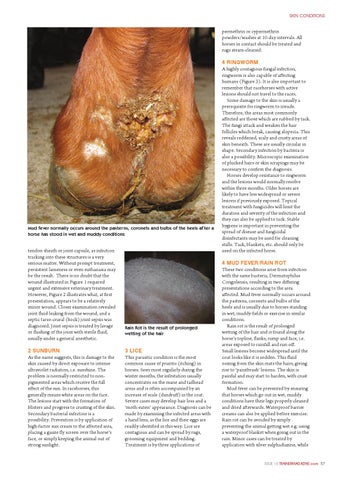SKIN NA.qxd:Jerkins feature.qxd
13/10/09
12:56
Page 2
SKIN CONDITIONS
permethrin or cypermethrin powders/washes at 10-day intervals. All horses in contact should be treated and rugs steam-cleaned.
Mud fever normally occurs around the paster ns, coronets and bulbs of the heels af ter a horse has stood in wet and muddy conditions
tendon sheath or joint capsule, as infection tracking into these structures is a very serious matter. Without prompt treatment, persistent lameness or even euthanasia may be the result. There is no doubt that the wound illustrated in Figure 1 required urgent and extensive veterinary treatment. However, Figure 2 illustrates what, at first presentation, appears to be a relatively minor wound. Closer examination revealed joint fluid leaking from the wound, and a septic tarso-crural (hock) joint sepsis was diagnosed. Joint sepsis is treated by lavage or flushing of the joint with sterile fluid, usually under a general anesthetic. 2 SUNBURN As the name suggests, this is damage to the skin caused by direct exposure to intense ultraviolet radiation, i.e. sunshine. The problem is normally restricted to nonpigmented areas which receive the full effect of the sun. In racehorses, this generally means white areas on the face. The lesions start with the formation of blisters and progress to crusting of the skin. Secondary bacterial infection is a possibility. Prevention is by application of high-factor sun cream to the affected area, placing a gauze fly screen over the horse’s face, or simply keeping the animal out of strong sunlight.
Rain Rot is the result of prolonged wetting of the hair
3 LICE This parasitic condition is the most common cause of pruritis (itching) in horses. Seen most regularly during the winter months, the infestation usually concentrates on the mane and tailhead areas and is often accompanied by an increase of scale (dandruff) in the coat. Severe cases may develop hair loss and a ‘moth-eaten’ appearance. Diagnosis can be made by examining the infected areas with a hand lens, as the lice and their eggs are readily identified in this way. Lice are contagious and can be spread by rugs, grooming equipment and bedding. Treatment is by three applications of
4 RINGWORM A highly contagious fungal infection, ringworm is also capable of affecting humans (Figure 3). It is also important to remember that racehorses with active lesions should not travel to the races. Some damage to the skin is usually a prerequisite for ringworm to invade. Therefore, the areas most commonly affected are those which are rubbed by tack. The fungi attack and weaken the hair follicles which break, causing alopecia. This reveals reddened, scaly and crusty areas of skin beneath. These are usually circular in shape. Secondary infection by bacteria is also a possibility. Microscopic examination of plucked hairs or skin scrapings may be necessary to confirm the diagnosis. Horses develop resistance to ringworm and the lesions would normally resolve within three months. Older horses are likely to have less widespread or severe lesions if previously exposed. Topical treatment with fungicides will limit the duration and severity of the infection and they can also be applied to tack. Stable hygiene is important in preventing the spread of disease and fungicidal disinfectants may be used for cleaning stalls. Tack, blankets, etc. should only be used on the infected horse. 4 MUD FEVER/RAIN ROT These two conditions arise from infection with the same bacteria, Dermatophilus Congolensis, resulting in two differing presentations according to the area affected. Mud fever normally occurs around the pasterns, coronets and bulbs of the heels and is usually due to horses standing in wet, muddy fields or exercise in similar conditions. Rain rot is the result of prolonged wetting of the hair and is found along the horse’s topline, flanks, rump and face, i.e. areas exposed to rainfall and run-off. Small lesions become widespread until the coat looks like it is sodden. This fluid oozing from the skin mats the hairs, giving rise to ‘paintbrush’ lesions. The skin is painful and may start to harden, with crust formation. Mud fever can be prevented by ensuring that horses which go out in wet, muddy conditions have their legs properly cleaned and dried afterwards. Waterproof barrier creams can also be applied before exercise. Rain rot can be avoided by simply preventing the animal getting wet e.g. using a waterproof blanket when going out in the rain. Minor cases can be treated by application with silver sulphadiazine, while ISSUE 14 TRAINERMAGAZINE.com 57
